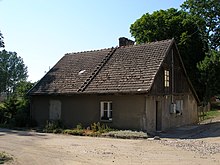Celbowo
| Celbowo | ||
|---|---|---|

|
|
|
| Basic data | ||
| State : | Poland | |
| Voivodeship : | Pomerania | |
| Powiat : | puck | |
| Gmina : | puck | |
| Geographic location : | 54 ° 41 ′ N , 18 ° 23 ′ E | |
| Residents : | 505 (2010) | |
| Telephone code : | (+48) 58 | |
| License plate : | GPU | |
Celbowo ( German Celbau ) is a village in the rural municipality of Puck in the Polish Pomeranian Voivodeship .
Geographical location
The village is located in the former West Prussia , about four kilometers south-southwest of the city of Puck ( Putzig ), ten kilometers north of the city of Wejherowo ( Neustadt in West Prussia ) and forty kilometers north of Gdansk .
The intersection of provincial roads 213 and 216 is nearby .
history
Renewing an old feast, Johann Rumpenheim , Commander of the Teutonic Order in Danzig , gives 30 Hufen to Jacob Brandeke on May 4, 1394 in Czillibow . In 1785 Celbau or Celbowo is referred to as a royal gradial property and village with nine hearths (households).
At the turn of the 18th to the 19th century, the Celbau manor was owned by the Putziger town judge Fähndrich; his nephew, who had often stayed at the estate for a long time, was Friedrich Gütte , administrative officer and, since 1819, the initiator of the establishment of the Sopot seaside resort .
Until 1919, the Celbau estate was part of the Putzig district in the West Prussian province of the German Empire .
After the end of the First World War , the district with the Celbau estate had to be ceded to Poland due to the provisions of the Versailles Treaty with effect from January 20, 1920, for the purpose of establishing the Polish Corridor . Due to the attack on Poland in 1939, the area of the corridor came to the Reich territory in violation of international law and was assigned to the Reichsgau Danzig-West Prussia .
Towards the end of the Second World War , the Red Army occupied the district in the spring of 1945 . As far as German residents had not fled, they were expelled from Celbowo in the following period and replaced by Poles.
The village today has about thirty buildings with u. a. farms . There is a palace-like mansion built in neo-Gothic style in the village . It was built in the 19th century for the Rodenacker family of brewers from Gdańsk. The building is now used by an agricultural organization and the parks have fallen into disrepair.
Population development
| year | Residents | Remarks |
|---|---|---|
| 1864 | 198 | |
| 1871 | 201 | in twelve residential buildings |
| 1905 | 194 | |
| 1910 | 225 |
literature
- Hans Prutz : History of the Neustadt district in West Prussia . Danzig 1872 ( style = "text-align: center" ).
Web links
Individual evidence
- ^ Hans Prutz : History of the Neustadt district in West Prussia . Danzig 1872, p. 50 .
- ^ Johann Friedrich Goldbeck : Complete topography of the Kingdom of Prussia . Part I, Königsberg / Leipzig 1785, Complete Topography of the West Prussian Cammer Department , p. 28.
- ^ New Nekrolog der Deutschen , Volume 21, Second Edition, Weimar 1845, pp. 819–824.
- ↑ Celbowo website about the village of Celbowo (Polish)
- ^ Prussian Ministry of Finance: The results of the property and building tax assessment in the administrative district of Danzig . Berlin 1867, 7th district Neustadt , p. 2, No. 19 .
- ^ Hans Prutz : History of the Neustadt district in West Prussia . Danzig 1872, p. 214, no.19 .
- ↑ wiki-de.genealogy.net ( page no longer available , search in web archives ) Info: The link was automatically marked as defective. Please check the link according to the instructions and then remove this notice.
- ↑ gemeindeververzeichnis.de



